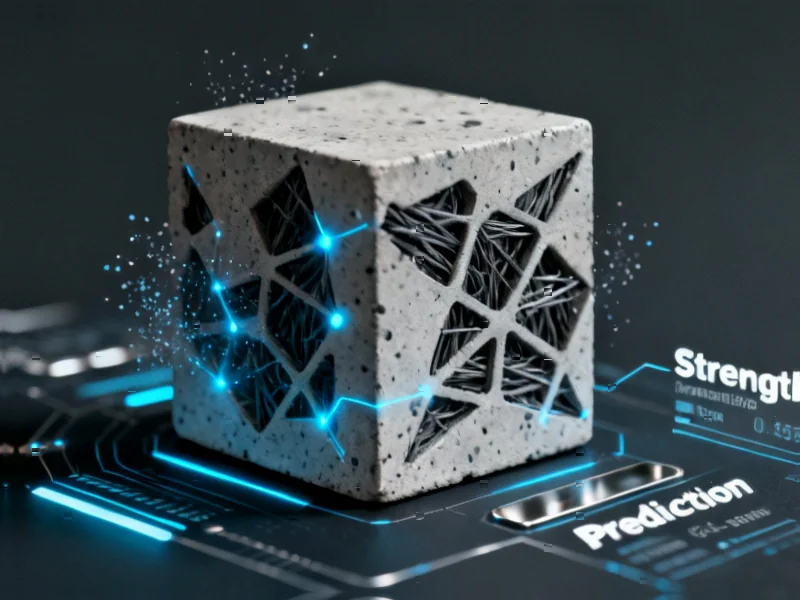Breakthrough in Sustainable Construction Materials
Construction industry professionals can now accurately predict the performance of eco-friendly concrete mixtures without costly laboratory experiments, according to recent research published in Scientific Reports. The study demonstrates how advanced machine learning algorithms can forecast the mechanical properties of basalt fiber-reinforced concrete (BFRC), a sustainable alternative to traditional steel-reinforced concrete that reportedly generates approximately 74% less carbon emissions.
Table of Contents
Machine Learning Models Outperform Traditional Methods
The research team utilized five different machine learning approaches—support vector regression (SVR), random forest regression (RFR), decision tree (DT), bagging regressor (BR), and gradient boosting regression (GBR)—to analyze 270 compressive strength and 267 splitting tensile strength samples. Sources indicate the dataset was divided into 70% training and 30% testing data, enabling robust model validation without additional physical experiments.
Analysts suggest the gradient boosting regression model demonstrated exceptional performance in predicting compressive strength, achieving an R² of 0.99 during training and 0.86 during testing. For splitting tensile strength prediction, the support vector regression model reportedly outperformed other algorithms with R² values of 0.99 and 0.97 for training and testing phases respectively.
Key Factors Influencing Concrete Performance
Through Shapley additive explanations (SHAP) analysis, researchers identified the most significant factors affecting concrete strength. The report states that cement and silica fume content showed the highest positive influence on both compressive and tensile strength. Basalt fiber diameter was found to be particularly crucial for splitting tensile strength predictions, according to the parametric analysis.
Basalt fiber reinforcement offers numerous advantages over traditional materials, sources indicate. The material reportedly possesses mechanical stability approximately 30% higher than regular glass fiber and superior corrosion resistance compared to steel reinforcement. This characteristic addresses a critical industry challenge, as analysts suggest approximately one in seven bridges in the United States requires significant corrosion-related repairs, costing nearly $4 billion annually.
Practical Application Through User-Friendly Interface
The research team has developed a graphical user interface that enables concrete designers to easily predict compressive and splitting tensile strength without conducting expensive computations or experiments. This accessibility reportedly makes sustainable concrete design more practical for widespread industry adoption.
According to reports, basalt fiber-reinforced polymer (BFRP) is rapidly gaining recognition as a leading sustainable building material due to its exceptional durability, strength, and corrosion resistance. The production process utilizes basalt rock, a naturally abundant resource, positioning BFRP as an environmentally friendly alternative that aligns with global sustainability goals.
Broader Implications for Construction Industry
The integration of machine learning in concrete design represents a significant advancement in construction technology. Researchers suggest this approach could substantially reduce both the financial and environmental costs associated with traditional concrete testing methods while accelerating the adoption of sustainable building materials.
Industry analysts indicate that fiber-reinforced polymer materials are becoming increasingly popular as alternatives to traditional steel reinforcement. The combination of advanced prediction models and sustainable materials like basalt fiber could potentially transform construction practices, particularly in applications requiring high corrosion resistance and environmental sustainability.
Related Articles You May Find Interesting
- US Government Explores Equity Investments in Quantum Computing Sector
- Samsung’s Galaxy XR Challenges Apple Vision Pro with Aggressive Pricing and AI I
- Beyond Crypto: How Ledger’s Latest Device Reinvents Digital Identity Security
- Advanced Machine Learning Models Revolutionize Molecular Crystal Analysis with U
- Apple Reportedly Joins Bidding War for Warner Bros. in Major Streaming Play
References
- http://en.wikipedia.org/wiki/Greenhouse_gas_emissions
- http://en.wikipedia.org/wiki/Basalt_fiber
- http://en.wikipedia.org/wiki/Random_forest
- http://en.wikipedia.org/wiki/Compressive_strength
- http://en.wikipedia.org/wiki/Fibre-reinforced_plastic
This article aggregates information from publicly available sources. All trademarks and copyrights belong to their respective owners.
Note: Featured image is for illustrative purposes only and does not represent any specific product, service, or entity mentioned in this article.



